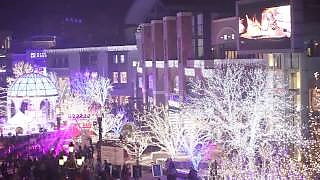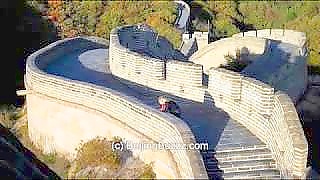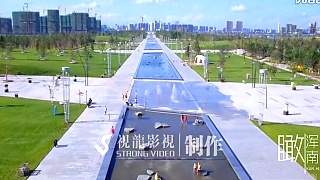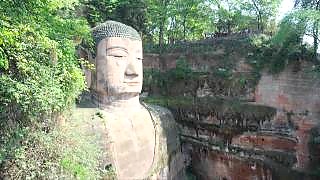Day Trips from Beijing, China
- Tianjin 天津 (Tiānjīn): Explore this coastal city known for its European-style architecture, the Tianjin Eye Ferris wheel, and the Ancient Culture Street. Take a leisurely stroll along the Haihe River, visit the Porcelain House, and sample local delicacies such as Goubuli Baozi (steamed stuffed buns) and mahua (fried dough twists).
- Chengde 承德 (Chéngdé): Visit the UNESCO-listed Mountain Resort and its outlying temples, including the Puning Temple and the Eight Outer Temples. Immerse yourself in the serene atmosphere of the Mountain Resort, explore the intricately designed temples, and marvel at the towering statue of Guanyin at the Puning Temple.
- Longqing Gorge 龙庆峡 (Lóngqìng Xiá): Experience the stunning natural beauty of Longqing Gorge, with its emerald green waters, towering cliffs, and scenic boat rides. Take a cruise along the gorge, ride the cable car for panoramic views, and enjoy outdoor activities such as rock climbing and bungee jumping.
- Simatai Great Wall 司马台长城 (Sīmǎtái Chángchéng): Explore the Simatai section of the Great Wall, known for its steep terrain, rugged beauty, and well-preserved watchtowers. Hike along the ancient wall, admire the panoramic views of the surrounding mountains and valleys, and experience the thrill of walking on one of China's most iconic landmarks.
- Qinhuangdao 秦皇岛 (Qínhuángdǎo): Relax on the beaches of Beidaihe or explore the Shanhaiguan Pass, where the Great Wall meets the sea. Spend a day soaking up the sun on the sandy shores, indulge in fresh seafood at beachside restaurants, and visit historical landmarks such as the First Pass Under Heaven.
- Chengde 承德 (Chéngdé): Visit the Chengde Mountain Resort, also known as the "Little Potala Palace," and the nearby Puning Temple with its giant statue of Guanyin. Explore the vast complex of palaces, temples, and gardens at the Mountain Resort, and marvel at the intricate architecture and religious artifacts at the Puning Temple.
- Qinghuang Island 秦皇岛 (Qínhuángdǎo): Take a boat trip to Qinghuang Island to visit the Old Dragon's Head, where the Great Wall meets the Bohai Sea. Explore the ancient watchtowers and fortifications, stroll along the beach, and enjoy panoramic views of the sea and surrounding coastline.
- Shanxi Pingyao 山西平遥 (Shānxī Píngyáo): Explore the ancient city of Pingyao, a UNESCO World Heritage Site known for its well-preserved Ming and Qing dynasty architecture. Wander through the narrow cobblestone streets, visit historic buildings such as the City Wall and Rishengchang Draft Bank, and learn about the city's rich history and cultural heritage.
- Chengde 承德 (Chéngdé): Discover the temples of Chengde, including the Putuo Zongcheng Temple, modeled after the Potala Palace in Lhasa, and the Temple of Universal Peace. Marvel at the grandeur of the imperial temples, explore the intricately carved halls and pavilions, and learn about the religious practices of Tibetan Buddhism.
- Langfang 廊坊 (Lángfáng): Visit the Nanhu Peach Blossom Village in Langfang during the spring to enjoy the beautiful peach blossoms in bloom. Take a leisurely stroll through the orchards, admire the colorful blooms, and participate in traditional activities such as peach blossom viewing and folk performances.
- Shijiazhuang 石家庄 (Shíjiāzhuāng): Explore the Cangyan Mountain Scenic Area and its ancient Buddhist grottoes, temples, and scenic landscapes. Hike along the mountain trails, visit the renowned Cangyan Mountain Grottoes, and admire the natural beauty of the surrounding valleys and waterfalls.
- Tianjin 天津 (Tiānjīn): Take a stroll along the Haihe River and explore the Italian Style Town, a neighborhood with European-style architecture and cobblestone streets. Visit historical landmarks such as the Tianjin Railway Station and the Former Residence of Liang Qichao, and sample Italian cuisine at local restaurants and cafes.
- Qinhuangdao 秦皇岛 (Qínhuángdǎo): Relax on the beaches of Nandaihe and enjoy seafood delicacies at local restaurants overlooking the sea. Swim in the clear waters, sunbathe on the sandy shores, and savor fresh seafood dishes such as steamed crabs, grilled fish, and fried squid.
- Chengde 承德 (Chéngdé): Visit the Qingchui Mountain, known for its stunning autumn foliage and panoramic views of the surrounding landscape. Take a scenic drive through the mountains, hike along the forest trails, and enjoy panoramic views of the colorful autumn leaves and distant peaks.
- Tangshan 唐山 (Tángshān): Explore the Tangshan Earthquake Memorial Park and Museum to learn about the devastating earthquake that struck the city in 1976. Visit the memorial hall, view exhibits on earthquake science and disaster prevention, and pay tribute to the victims of the earthquake at the memorial square.
- Jietai Temple 戒台寺 (Jiètái Sì): Discover the ancient Jietai Temple, known for its beautiful Buddhist architecture and serene surroundings. Explore the temple complex, admire the intricate carvings and statues, and participate in Buddhist rituals such as meditation and prayer.
- Badachu 八大处 (Bādàchù): Explore the scenic area of Badachu, home to eight ancient Buddhist temples nestled in the hills of Western Beijing. Climb the stone steps to each temple, admire the ancient architecture and religious artifacts, and enjoy panoramic views of Beijing from the hilltops.
- Xiangshan Park 香山公园 (Xiāngshān Gōngyuán): Enjoy hiking and panoramic views of Beijing from Xiangshan Park, also known as Fragrant Hills Park, especially beautiful during autumn. Take a leisurely stroll through the forested hills, climb to the mountain peak for panoramic views of the city, and admire the vibrant colors of the autumn foliage.
- Shilinxia Glass Platform 石林峡玻璃栈道 (Shílíngxiá Bōlí Zhàndào): Experience the thrill of walking on the glass platform suspended over the Shilinxia scenic area, offering stunning views of the surrounding landscape. Walk along the transparent walkway, peer over the edge to see the valley below, and take in the breathtaking scenery of the rugged cliffs and rock formations.
- Wuling Mountain 武陵山 (Wǔlíng Shān): Escape to the tranquility of Wuling Mountain, known for its lush forests, waterfalls, and hiking trails. Explore the mountain paths, discover hidden waterfalls and streams, and enjoy outdoor activities such as hiking, picnicking, and birdwatching.
Beijing, the capital city of China, is a vibrant metropolis steeped in history, culture, and modernity. Here's a brief overview of what you can expect as a tourist in Beijing:
Historical Landmarks:
The Great Wall of China: One of the most iconic structures in the world, the Great Wall is easily accessible from Beijing. Mutianyu and Badaling sections are popular among tourists.
Forbidden City (Palace Museum): A UNESCO World Heritage Site, this vast imperial palace complex was home to Chinese emperors for over 500 years. It houses numerous halls, courtyards, and historical artifacts.
Temple of Heaven: A masterpiece of Chinese architecture, this ancient temple complex served as a place of worship for emperors to pray for good harvests.
Summer Palace: A stunning ensemble of lakes, gardens, and palaces, the Summer Palace served as a retreat for emperors during the Qing dynasty.
Tiananmen Square: One of the largest city squares in the world, Tiananmen Square is flanked by important landmarks such as the Monument to the People's Heroes, the Great Hall of the People, and the Mausoleum of Mao Zedong.
Cultural Sites:
Beijing Hutongs: Explore the narrow alleyways and traditional courtyard residences of Beijing's historic neighborhoods. You can take a rickshaw tour or simply wander around on foot.
Beijing Opera: Experience traditional Chinese opera performances at venues like the Liyuan Theater or the Chang'an Grand Theatre.
798 Art District: A hub of contemporary art and culture, this former industrial area is now home to numerous galleries, studios, and cafes.
Modern Attractions:
Olympic Park: Visit iconic structures such as the Bird's Nest (National Stadium) and the Water Cube (National Aquatics Center) from the 2008 Beijing Olympics.
CBD (Central Business District): Marvel at the futuristic skyline of Beijing's modern business district, which includes landmarks like the CCTV Headquarters and the China World Trade Center Tower III.
Culinary Delights:
Peking Duck: Indulge in Beijing's most famous dish, crispy roast duck served with pancakes, scallions, and hoisin sauce.
Street Food: Explore the city's vibrant street food scene and sample local delicacies like jianbing (savory crepes), lamb skewers, and dumplings.
Practical Tips:
Transportation: Beijing has an extensive public transportation system, including the subway, buses, and taxis. However, traffic can be heavy, so plan your travels accordingly.
Language: While English is not widely spoken, especially outside tourist areas, many signs and transportation announcements are in English. It's helpful to carry a translation app or a phrasebook.
Weather: Beijing experiences four distinct seasons, with hot summers and cold winters. The best times to visit are spring (April to June) and autumn (September to October) when the weather is mild and comfortable.
Etiquette: Respect local customs and traditions, such as removing your shoes before entering someone's home and using both hands to pass or receive items.
Beijing offers a rich tapestry of experiences for tourists, blending ancient heritage with modern innovations. Whether you're fascinated by history, culture, or culinary delights, there's something for everyone in this dynamic city.
 Day trips from BeiJing
Day trips from BeiJing













